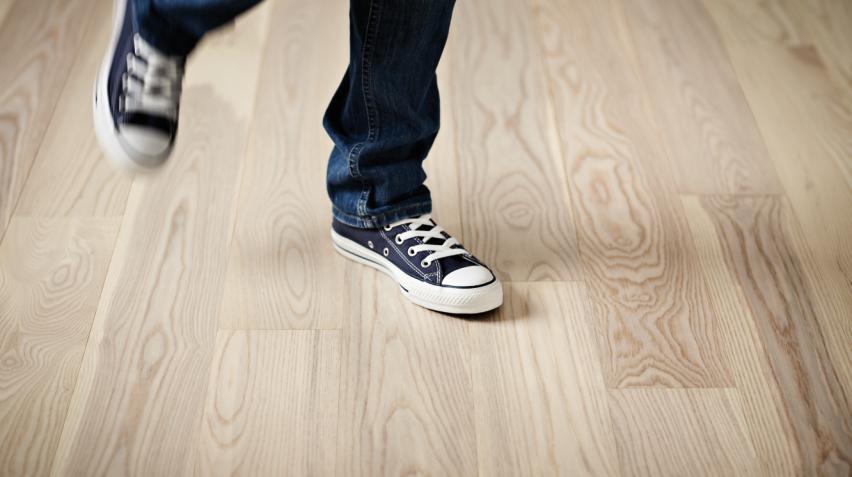How to Remove Paint from a Wood Floor
Paint spills and splatters on wood floors are a common challenge during home improvement and DIY projects. Whether you’re dealing with a fresh drip or a stubborn, dried stain, knowing the right techniques can help restore the natural beauty of your hardwood without causing damage. In this guide, you’ll find safe, effective methods for removing both water-based and oil-based paints from your wood flooring. We’ll walk you through the necessary steps, the recommended tools, and important safety precautions—so you can tackle paint stains with confidence and keep your floors looking their best.
Understanding Your Wood Floor and Paint Stains
Every wood floor has its unique qualities, whether you have a classic plank floor, a 2-strip floor, or a more decorative option like herringbone parquet or HexParket. Junckers floors are crafted from premium wood species such as oak, ash, and beech and come with a variety of surface treatments, from ultra matt lacquer to nature-inspired oil. These finishes not only highlight the wood’s natural grain but also impact how the floor responds to paint stains.
Before you attempt to remove paint from wood floor surfaces, it’s important to know the type of wood and finish you have. Some surfaces are more sensitive to moisture or chemicals, while others offer extra resilience. If you’re unsure, consult your floor’s documentation or refer to the guidance on how to clean and maintain your hardwood floor for expert advice—taking these first steps helps ensure your floor stays beautiful for years to come.
Essential Tools and Materials for Safe Paint Removal
To remove paint from wood floor surfaces safely and effectively, gather the following supplies:
- Plastic putty knife or scraper (avoid using metal to prevent scratches)
- Microfiber cloths or soft sponges
- Mild dish soap
- Warm water
- Rubbing alcohol, denatured alcohol, or mineral spirits (for tougher stains)
- Protective gloves
- Small bowl or bucket
Using gentle, non-abrasive products is vital to protect your floor’s finish. Always select cleaning products that are safe for use on factory-finished wooden floors and avoid harsh chemicals or abrasive pads that can damage the surface.
Step-by-Step Guide to Remove Paint from Wood Floor
Restoring your floor’s natural appearance starts with a careful, step-by-step approach. Follow the instructions below for best results.
Identify the Type of Paint
First, determine whether the paint is water-based or oil-based. Water-based paints, such as latex or acrylic, are generally easier to remove. Oil-based paints may require different solvents and extra care. If you don’t know the type, try dabbing a small amount of rubbing alcohol on a cloth and testing a hidden area of the paint—if the color transfers, it’s likely water-based.
Remove Water-Based Paint Safely
- Mix a few drops of mild dish soap with warm water in a bowl.
- Dampen a microfiber cloth in the solution and gently rub the paint in the direction of the wood grain.
- For stubborn spots, use a plastic scraper or the edge of a credit card to carefully lift the paint, avoiding excessive pressure.
- Wipe the area with a clean, damp cloth to remove any remaining residue.
If your floor is lacquered, you can find regular care tips for maintaining a scratch-free surface and protecting the finish in the guide on cleaning lacquered wood floors.
Remove Oil-Based Paint Without Damaging Your Floor
- Gently scrape off as much dried paint as possible with a plastic putty knife.
- Moisten a cloth with rubbing alcohol or mineral spirits. Always test in an inconspicuous area first to check for any reaction with your floor’s finish.
- Carefully rub the paint spot, using gentle, circular motions.
- After the paint lifts, wipe clean with a damp cloth to remove any traces of solvent.
For oiled wood floors, learn how to keep them looking beautiful by following the oiled wood floor cleaning guide.
Alternative Methods for Stubborn Paint Spots
Sometimes, small or stubborn paint spots require more than one approach.
- A mixture of isopropyl alcohol and a few drops of lemon juice can help break down tougher stains.
- For dried paint, use a hairdryer on a low heat setting to soften the spot before gently scraping.
- If needed, use a commercial paint remover suitable for wood floors—always follow the product instructions and test first on a hidden section.
If your floor is soap-treated, you can follow specific care steps in the cleaning soap-treated hardwood floors guide.
Safety Tips and Precautions
Protecting both your floor and yourself is essential during the paint removal process:
- Work in a well-ventilated area, especially when using solvents like rubbing alcohol or mineral spirits.
- Wear protective gloves to prevent skin contact with cleaning agents.
- Never use harsh chemicals, sandpaper, or excessive force, as these can damage the wood or its finish.
- Always test any cleaning solution on a small, hidden area to ensure compatibility with your floor’s surface.
Aftercare: Restoring and Maintaining Your Wood Floor
Once you have managed to remove paint from wood floor surfaces, finish by wiping the area with a clean, damp cloth and drying it gently with a soft towel.
To restore the floor’s shine and protective qualities, consider buffing with a dry microfiber cloth. If the paint removal process has dulled or affected the finish, refer to Junckers’ guidance for maintenance of lacquered wood floors or maintenance of oiled wood floors for information on reapplying a suitable surface treatment. This helps preserve both the appearance and durability of your floor for years to come. For broader advice, see the section on cleaning and maintenance of hardwood floors.
When to Contact a Professional for Help
If you encounter a large spill, persistent stains, or uncertainty about your floor’s finish, consider reaching out to a professional. Some situations require expert knowledge and specialized tools to avoid unintentional damage. For tailored advice or a referral to a trusted specialist, you are welcome to contact Junckers directly.
Learn More About Caring for Your Junckers Floor
Proper floor care extends the life and beauty of your investment. Explore detailed cleaning and maintenance tips for hardwood floors, or get step-by-step guidance for oiled, lacquered, or soap-treated wood floors. For additional questions or personal assistance, you can always reach out to customer support.



